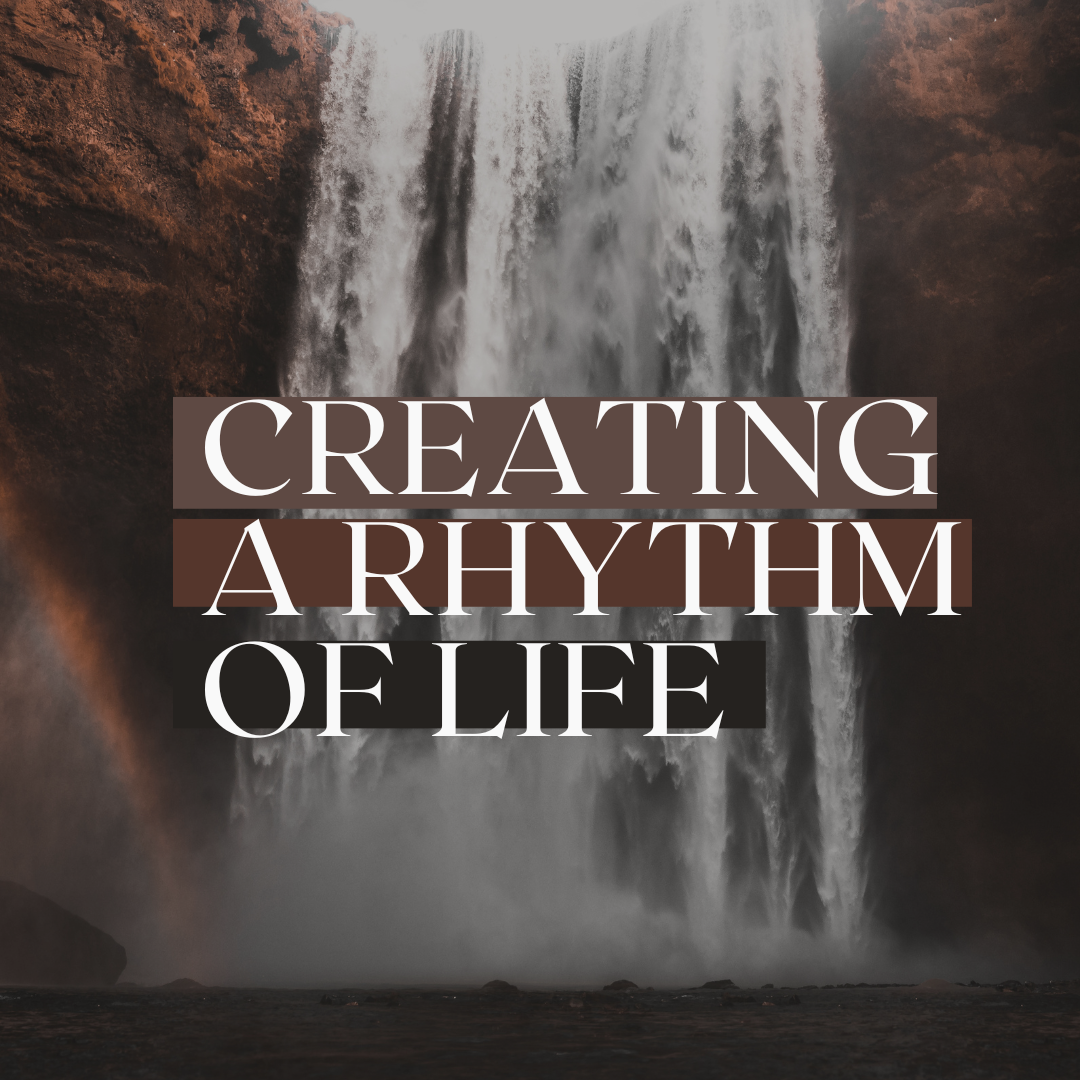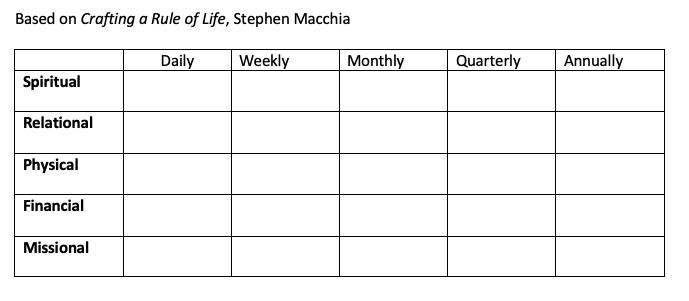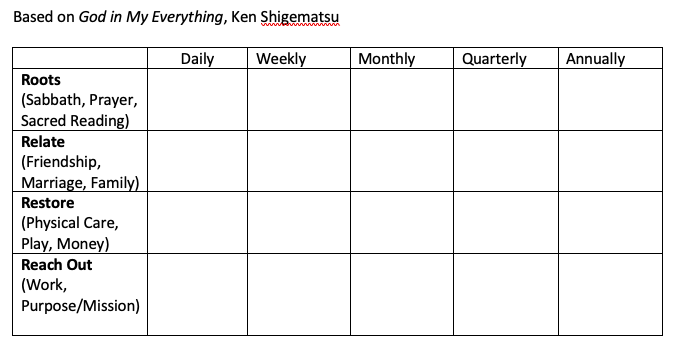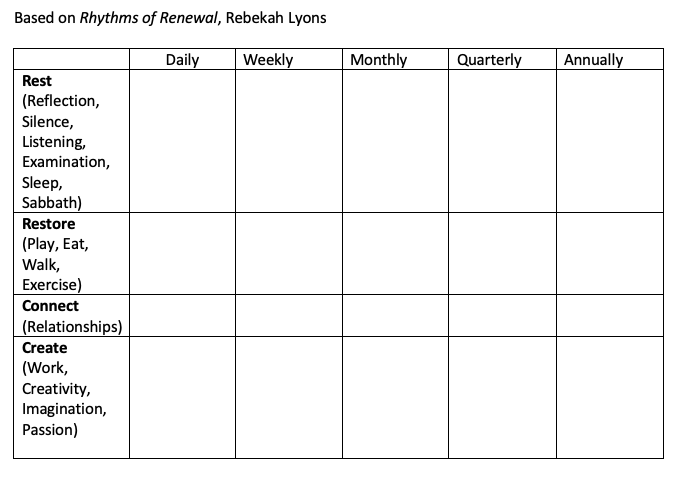|
Rhythm is hardwired into all of creation. Day and night, tides, seasons, migration patterns, and our own biological rhythms—all are evidence that rhythm is integral to life. Our very breath and heartbeat are continual reminders of the natural rhythms that sustain us. Something as simple as an irregular heartbeat or interrupted breath can cause great distress and even be fatal. Rhythm is equally critical to the way that we live. I’ve learned this the hard way, when I’ve allowed life-giving rhythms to be crowded out by the busyness and chaos of life. My guess is that you have too! When our lives are out of rhythm, it affects us mentally, emotionally, physically, and spiritually. We might describe it as feeling… overwhelmed stressed out worn out exhausted out of sorts unbalanced off kilter off track burned out adrift run down confused …or a myriad of other things. But whatever words we might use, we have a sense that—despite our faith and spiritual activity—we’re lacking something necessary for a life of joy, meaning, and fulfillment. Often what we’re lacking is not any one thing—not a vacation or a new self-care practice, though those are good things—but a rhythm of life. What Is a Rhythm of Life? A rhythm of life is simply a rhythm of practices or habits that help us to experience God in our daily activities and live fully as our authentic selves—the wonderfully unique individuals God created us to be. We might say a rhythm of life is a way of living wide awake to God. Like listening to beautiful music with a steady beat, living according to a rhythm of life is pleasant and inviting. It feels right—like a “get to” instead of a “have to.” It feels light and free, not heavy or limiting. Jesus said his yoke is easy and his burden is light (Matthew 11:28-30). The Message Bible expresses it so beautifully: “Walk with me and work with me—watch how I do it. Learn the unforced rhythms of grace. I won’t lay anything heavy or ill-fitting on you. Keep company with me and you’ll learn to live freely and lightly.” These unforced rhythms of grace look different from person to person and even stage to stage in our own lives. Margaret Guenther writes, “What liberates one person may constrict another…Likewise, what serves me well at this stage of my life would have been quite wrong, even damaging, for me as a twenty-year-old."* Your rhythm of life, then, consists of the life-giving habits that help you to grow and flourish in your walk with God in this season. After all, there is no formula for spiritual vitality and growth, and we need different practices in different seasons. So, a rhythm of life is a working document that we review and revise regularly. Your rhythm of life consists of the life-giving habits that help you to grow and flourish in your walk with God in this season. It's important to remember that the practices in our rhythm of life are not ends in themselves. They are not about performing or achieving or manipulating our own health or growth. They are not even about establishing "balance," because that's unrealistic. We all know that some areas of life can be more demanding at certain times. The purpose of the practices in our rhythm of life is simply to position us to experience and enjoy God. That’s why I prefer the term “rhythm of life” over “rule of life”—another term commonly used for what I’m describing—because the very word rhythm connotes flexibility and grace. If you feel you don’t need a rhythm of life, here’s the truth: you already have one; it’s just unwritten and may be a rhythm of disharmony rather than a rhythm of grace. Justin Earley writes, “We are all living according to a specific regimen of habits, and those habits shape most of our life”—and I would add, “for better or worse.”** We are shaped by the habits that make up our days. The question we must ask ourselves is, How are my habits shaping me? Perhaps it is time to replace an unwritten rhythm with an intentional and prayerfully crafted one that will help you to live into your most authentic self and experience the fullness of life and love God desires for you. We are shaped by the habits that make up our days. The question we must ask ourselves is, How are my habits shaping me? How Do I Create a Rhythm of Life? There are many excellent books on creating a rhythm or rule of life (see Recommended Resources below), so it is not my intention to provide an exhaustive discussion here. Instead, here are a few simple guidelines to help you get started. 1. Prime the pump by prayerfully considering a few “big picture” questions. Take some time to reflect and pray with these questions—and feel free to add others. Though you may not have an answer for each question (and that’s okay!), simply considering them will help to prepare you for the process of creating a rule of life. You might find it helpful to write your thoughts in a journal or notebook or record your responses in a voice memo on your phone or computer. Again, the questions are intended simply to orient you toward the purpose or focus of a rhythm of life.
2. Determine the framework for your rhythm of life. There are many formats you can use when creating a rhythm or rule of life. As you prepare to identify the practices and habits you find most life-giving and supportive of who you are called to be in this world, consider what categories make the most sense or have the most appeal for you. Below are several examples. There are many other possibilities as well. Once you choose a format, begin to write the most life-giving practices and habits related to each category. The idea is not to fill every box or create a to-do list—we have enough of those! The idea is to focus on the essential, life-giving rhythms that are right for you in this season. Perhaps it's time to renew some practices that have fallen by the wayside or try some new practices—especially new spiritual practices that might breathe life into your relationship with God. If desired, you can include additional elements in your rhythm of life—such as key Scriptures and songs, your roles and values, a personal mission statement, and even representative photos or artwork. If that’s your jam, go for it and get creative! If that sounds oppressive, just keep it straightforward and simple. Either way, give yourself permission to do it your way and make it your own. For a variety of examples, visit www.ruleoflife.com/myrule 3. Eliminate the non-essentials. Now comes the hard part. Determine which practices are most important—those you consider vital. My spiritual director encourages eliminating at least half of what you’ve recorded! The idea is to streamline your rhythm or rule so that it is doable, something you’re able to commit to with consistency. It can be helpful to share your abbreviated version with someone you trust and respect—a spouse, spiritual director, or friend—and invite feedback and accountability. Is this a practical plan for a rhythm of habits, rather than a list of goals or wishes? Are you missing anything? 4. Prayerfully live into your rhythm and revise as needed. This may be the most important part of the process. Creating a rhythm of life can—and should—take time and involve careful reflection, prayer, and even experimentation. I spent an entire year creating and revising a new rhythm of life when transitioning from a career in publishing to full-time spiritual direction, and during that time I “tried on” different practices to discover what my soul truly needed and desired in this new season. Once you have your list of essential practices or habits on paper, you’re then able to prayerfully live into them, listening to the Spirit and making revisions as you feel led. It can be helpful to set a reminder on your phone or calendar so you can be intentional in reflecting on your rhythm of life, whether monthly, quarterly, or (at the very least) annually. Throughout the process, let your attitude toward yourself be one of grace. Above all, remember that a rhythm of life is not meant to be a checklist demanding rigidity or performance but a loving invitation and gentle guide toward the unforced rhythms of grace that God desires for you! Above all, remember that a rhythm of life is not meant to be a checklist demanding rigidity or performance but a loving invitation and gentle guide toward the unforced rhythms of grace that God desires for you! Recommended Resources
Notes *Margaret Guenther, At Home in the World: A Rule for the Rest of Us (New York, NY Seabury Boos, 2006), 179. **Justin Whitmel Earley, The Common Rule: Habits of Purpose for an Age of Distraction (Downers Grove, IL: InterVarsity, 2019).
0 Comments
Your comment will be posted after it is approved.
Leave a Reply. |
Hi, I'm Sally!
I'm passionate about connecting with God and connecting with people, offering spiritual encouragement and companionship. I'm so grateful to be on the journey with you as we walk with God together. subscribeArchives
July 2024
Categories
All
|
|
Copyright 2019 Sally Sharpe Spiritual Direction |
Proudly powered by Weebly
|






 RSS Feed
RSS Feed
